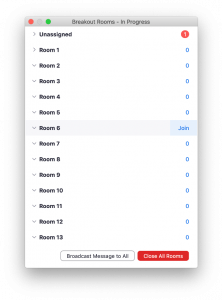For the breakout discussions, we will use breakout rooms in zoom. Be sure to update your zoom client so you can choose your own breakout room! See instructions for selecting a breakout room in zoom at the end of this page.
Day 1 Breakout discussion topics
MexFlux: past, present and future directions of carbon and water fluxes monitoring in mexican ecosystems
Led by: Dr. Tonantzin Tarin, Dr. Susana Alvarado-Barrientos, Dr. Enrico A. Yepez, Dr. Rodrigo Vargas
MexFlux is the national network for flux measurements of carbon, water and energy as well as greenhouse emissions in Mexican ecosystems. The aim of MexFlux is to understand how climate and land use changes affect ecosystems functioning in a phase of changing environment. We are proposing a breakout session for the engagement of the MexFlux community and a dialogue with AmeriFlux to briefly account the MexFlux progress to date. Also, we would like to encourage the feedback on the potential of Mexican efforts measuring fluxes in seasonal (i.e., campaign based) and agricultural systems (i.e. inter- annual cropping cycles) for contributing to broader applications (i.e. national and regional synthesis). This session would also serve as an invitation to forthcoming activities MexFlux and the Programa Mexicano del Carbono.
Improving integration of sap flux and other tree-level ecophysiological measurements with AmeriFlux datasets
Led by: Justine Missik
Many flux sites have collected a wealth of tree-level ecophysiological measurements (e.g. sap flux, leaf water potential, tree ring data, DBH census, etc) that are not easily documented and shared alongside eddy covariance datasets. New databases such as SAPFLUXNET have helped to collect more ecophysiological data in one place, but these databases are not easily integrated with flux databases and overlap with flux sites is limited. For some types of measurements, databases have yet to be created. This makes synthesis activities that include both flux measurements and other valuable ecophysiological information difficult. In this breakout session, we will discuss the best ways of effectively sharing tree-level ecophysiological measurements alongside eddy covariance data to facilitate synthesis activities. Discussion topics could include:
1) Identifying existing measurements that could potentially be useful to collect and integrate with AmeriFlux data
2) Identifying site-level and tree-level metadata that is needed to link tree- and plot-level data to one other (e.g., species-specific LAI, crown diameters). Is data available for sites and not reported?
3) How to incentivize data collection and sharing of tree-level ecophysiological measurements at AmeriFlux sites.
4) Best methods for collecting information from sites and organizing new databases
5) Existing databases that could be linked with AmeriFlux, and the best ways to make other databases easily accessible to users of flux data
Flux Data in the Classroom: Curriculum Development
Led by: David Reed
For those of us with teaching responsibilities, while the course title might vary between institutions, course material has significant overlap for all of us. To serve as a community resource for all, those interested in development of course material for both undergraduate and graduate level courses can meet to discussion plans. Feedback on what would used and useful by the community is needed, ranging from lecture material or data-based project assignments or potential co-teaching or recording lectures.
Incorporating Artificial Intelligence into Ameriflux Research
Led by: Thomas Y. Chen, Yangui Kang, Trevor Keenan
Studying the climate, CO2, land-atmosphere interactions, and ecosystems is crucial to our understanding of a planet under threat from anthropogenic climate change. Recently, innovative artificial intelligence and machine learning-based approaches have been increasingly integrated into the research of members of the Ameriflux community. Techniques range from approaches as simple as linear regression to more complex ones such as classification, clustering, decision trees and ensemble models, support vector machines, and neural networks. Applications include computer vision for the assessment of ecosystems and machine learning for the monitoring of spatial and temporal variability. The session will begin with an introduction by the lead and one invited speaker. After, there will be open, facilitated discussion about the range of intersections at the nexus of AI and the Ameriflux network. Finally, there will be a free period at the end where attendees can mingle and possibly develop collaborations or discuss future research directions. The outcome is likely to be a collaborative white paper drafted among the attendees after the session that outlines how machine learning approaches can be included in Ameriflux areas of interest. This will be coordinated by the breakout leads and may end in the form of a submission to a peer-reviewed publication.
Day 2 Breakout discussion topics
AmeriFlux Natural Climate Solutions Working Group: Next Steps
Led by: Kim Novick, Marcy Litvak, Dave Hollinger, Stefan Metzger, Kyle Hemes, Daniela Cala, and Margaret Torn
The AmeriFlux Science Steering Committee has formed a new working group focused on enhancing the usefulness of AmeriFlux data for Natural Climate Solutions (NCS). NCS are strategies to manage or preserve ecosystem services to reduce greenhouse gas (GHG) emissions or enhance their sequestration. We love to hear your ideas about the most effective and creative ways to engage with you on this important topic, and our community call for nominations has already received an enthusiastic response. This breakout will serve to align group purpose, vision and mission, to determine concrete future activities, appoint topical leads and agree on a process for group rapport. Envisioned activities include but are not limited to:
– Creating an AmeriFlux-NCS list-server.
– Convening NCS-themed sessions at conferences and meetings (ESA, AGU, EGU, AMS, etc).
– Creating a community bibliography of NSC-themed research that uses or has conceptual links to AmeriFlux data.
– Creating a living calendar of scientific seminars, meetings, and other virtual or in-person events focused on NCS.
– Creating a journal special issue on flux community contributions to NCS quantification.
ET challenges and opportunities
Led by: Kyle Delwiche, Koong Yi, Trevor Keenan
Evapotranspiration (ET) measurements at AmeriFlux sites are a rich data resource for understanding ecosystem functioning, and there are significant challenges and opportunities associated with interpreting, gap-filling, partitioning, and ground-truthing ET data. This breakout session will include talks on recent advances in ET science, and a discussion on critical next-steps for the ET flux community. We will use interests and discussion from this breakout session to establish the priorities and goals for a follow-up ET workshop that AmeriFlux will host in November 2021.
Towards FLUXNET-CH4 2.0: Identifying new strategies, leadership, and science priorities for future eddy covariance measurements of methane fluxes
Led by: Gavin McNicol, Theresia Yazbeck
Over the last year, the FLUXNET-CH4 synthesis activity, coordinated between AmeriFlux, EuroFlux, and the Global Carbon Project, came to fruition in the public release of the first global dataset of eddy covariance methane fluxes. This effort also provides lessons for future expansion and use of the dataset. With this breakout we would like to help maintain the momentum built for the original synthesis, and ask you: What strategies worked for building the global dataset and organizing synthesis projects? How might we update FLUXNET-CH4 with new data and processing methods, and how can we recruit early career leadership for this effort in coordination with FLUXNET-Coop? We will also discuss science, asking: What are the fundamental and emerging scientific questions we can address with methane flux data, and how can we couple these data with modeling efforts? We will split time between strategy and science discussions.
Day 3 Breakout discussion topics
Advancing land-atmosphere interactions research at flux tower sites through integration of boundary layer observations
Led by: Manuel Helbig, Eric Beamesderfer
Land-atmosphere feedbacks result from the close coupling of land surface, atmospheric boundary layer, and free troposphere, and integrated surface flux and atmospheric observations provide an important tool to better understand these complex systems. Over the past two years, community efforts have led to the publication of a review paper and to an international virtual workshop on this topic, which have outlined important research directions in this field. In this session, we will discuss in breakout groups the way forward to tackle the new research questions at AmeriFlux tower sites.
Informing models with AmeriFlux observations: needs and opportunities from the AmeriFlux-RUBISCO working group
Led by: Zelalem Mekonnen, Chi Chen
This breakout session is an opportunity to discuss new approaches to evaluate models using AmeriFlux observations, to investigate the extent to which AmeriFlux observations can be used to reduce model uncertainty, and to inspire new frameworks for model representations. It is led by the RUBISCO-AmeriFlux working group, a collaboration between DOE’s RUBISCO Scientific Focus Area and the AmeriFlux Management Project, which brings together scientists at multiple levels across a broad range of fields. A novel aspect of the Working Group is an incubator for early-career scientists to develop research projects and leverage facilities and expertise of the RUBISCO and AmeriFlux teams. Expected outcomes include long-term collaborations, follow-on focus groups, and publications.
Eddy Covariance Measurements in Urban Environments
Led by: Sebastien Biraud, Jiquan Chen, Ken Davis
The application of the EC technique in urban environments is challenging due mostly to the heterogeneous landscape and a required hands-on interpretation of the collected observations. Nevertheless, EC systems can be deployed to provide important insights on fluxes of trace gases (e.g., CO2, CO, NOx, CH4, aerosol particles, etc.) and energy (sensible and latent heat, radiation). This breakout discussion will compile challenges and solutions for EC flux measurements in urban environments, whether in “green” or “gray” parts of urban areas, and distill the dimensions of applications, caveats, and recommendations.
How to join and switch breakout rooms
How to join your breakout room
For the breakout discussions, we will utilize zoom breakout rooms. Please be sure to update your version of zoom before the meeting, so that you have full functionality. When the breakout rooms have been opened, you will see the breakout room icon appear at the bottom of the Zoom control bar:

The breakout room icon looks like this:

but it could also be hidden in here:

Because of the large number of participants, we are asking each participant to navigate themselves to the correct breakout room. All you have to do is click the breakout room icon, which will bring up a panel of available breakout rooms shown below. Point your mouse to the right room and click “Join”. At the end of each breakout session, the Host will close all the Breakout Rooms and you will be brought back automatically to the main Zoom Room.

How to get back to the main room
If you wish to leave the breakout room before the discussion session is over, navigate to the lower-right corner of your Zoom tools where you should see a button labeled “Leave Room”. This button will give you the option to either leave the breakout room and return to the main Zoom room, or to leave the meeting altogether. One member of the planning committee will be in the main room during all breakouts.

At the end of each breakout session, the host will close the open breakout rooms, and in 60 seconds everyone will automatically be brought back to the main Zoom room.
